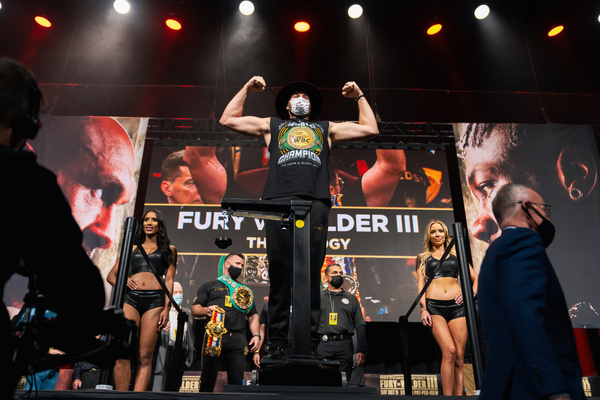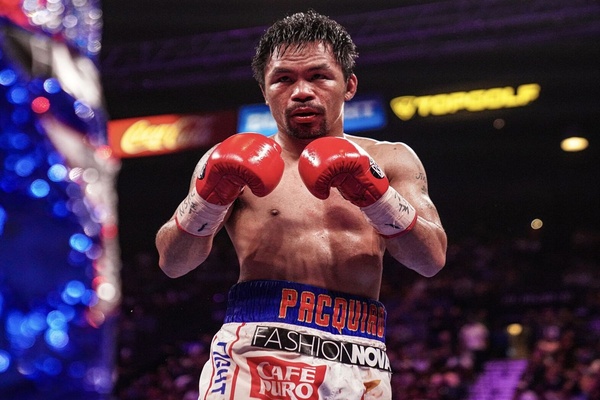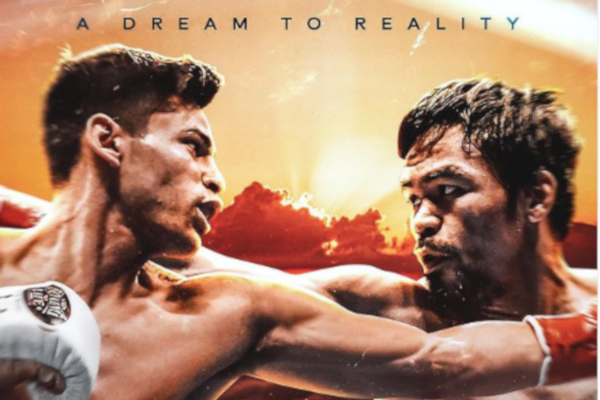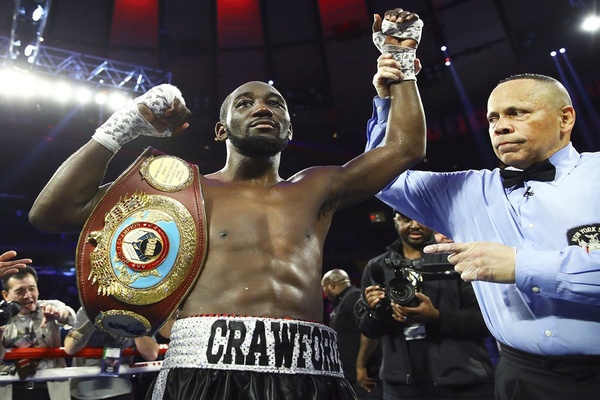Manny Pacquiao vs Yordenis Ugas and the fascinating history of boxing’s late substitutes
Derek Bonnett recalls six compelling examples of late-notice replacements in boxing, setting it in the context of Manny Pacquiao vs Yordenis Ugas

Manny Pacquiao versus Errol Spence presented an intriguing match-up to excite boxing fans amid the stalled starts of Anthony Joshua-Tyson Fury, Fury-Deontay Wilder III and Teofimo Lopez-George Kambosos. With about two weeks to go, news broke that Spence suffered a torn retina in training and would no longer be able to fight the biggest bout of his career.
In many circumstances the collapse of a main event could mean the postponement or cancellation of the entire card. However, Pacquiao’s status was more than enough to carry the weight of the promotion. A second scenario could have been seeing Pacquiao matched with an unheralded contender with a perfect résumé or a worn contender on his last leg.
To the delight of boxing fans worldwide, we were served up a third option: a top contender in his prime. Enter Yordenis Ugas, 35, who was already in preparation to battle Fabian Maidana in the chief supporting bout to Pacquiao-Spence, so there will be no disadvantages in terms of physical preparations.
Since dropping a controversial split decision to Shawn Porter in 2019, Ugas, 26-4 (12), has produced a career-best run by defeating Omar Figueroa, Mike Dallas and Abel Ramos. Ugas has not only earned his big fight, he’s a live underdog, who has fought three times since Pacquiao outpointed Keith Thurman in 2019. Pacquiao-Ugas is about as good as it gets in lieu of the Spence clash.
The latest odds for Pacquiao vs Ugas, are favouring Pacquiao even more at -360. Fans across the US will be looking to bet on Pacquiao or Ugas to upset the odds. You can look at the current states that allow online gambling listed here. Ugas is currently a +240 underdog.
Ugas is in the position of a lifetime due to the name of his dance partner, but his situation is far from unique in terms of boxing history. Due to the nature of the sport, injuries are commonplace and bouts fall through or are delayed quite often - even major pay-per-view events with a brilliant marquee. We can expect the best from Ugas, but don’t know if that will be enough to defeat the icon that is Manny Pacquiao. Boxing remains the theater of the unexpected, so we will all tune in to find out, just like we did when these other late replacements stepped into the ring seeking greater fortune.
July 21, 1982 – Salvador Sanchez vs Azumah Nelson
That night in Madison Square Garden was supposed to see Sanchez defend the lineal featherweight title against Colombia’s Mario Miranda. Just a month before, Miranda had stopped Marcos Villasana on cuts, but the unknown Nelson was brought in as a last-second replacement. Nelson was expected by most to only provide a few rounds of work given his complete lack of experience at the world-class level in thirteen bouts.
Instead, Nelson began forging his path into the International Boxing Hall of Fame with a completely unexpected performance. Arguably, Nelson pushed Sanchez harder than any of his previous foes. The Ghanaian warrior answered back when he was caught and pushed and pressed the Mexican champion’s legendary stamina to its limits. When a left hook rattled Nelson in the seventh and a second put him on the canvas, the neophyte responded with greater determination rather than wilted confidence. Translations from the corner reveal that Sanchez was tiring and troubled by his unknown nemesis, but he too did not know how to fold.
Sanchez prevailed in the end as the inexperienced challenger came out to finish the champion in the last round, believing his time had come. Sanchez used the left hook again to hurt Nelson and sent him down in his own corner. Nelson rose at the count of two, but was stopped on his feet roughly 15 seconds later in the fifteenth. No one knew it then, but Nelson would go on to become an all-time great himself and, likely, the greatest late sub in boxing history.
June 23, 1986 – Barry McGuigan vs Steve Cruz
Barry McGuigan planned to fly to Las Vegas, Nevada and showcase his talents on a card featuring both Thomas Hearns and Roberto Duran in separate bouts. For “The Clones Cyclone”, his opponent would be Argentine Fernando Sosa, a light-punching featherweight with a nice résumé on paper. Like Sanchez, McGuigan was the lineal featherweight champion following a win over Eusebio Pedroza. Like Spence, Sosa was forced to pull out due to retinal damage – two detached retinas to be precise! Steve Cruz, a plumber by trade and unafraid to get his hands dirty, stepped in as a relative unknown with three weeks to prepare.
Cruz arrived ready to produce a surprise, but it would prove more of a stand-alone performance rather than a path to greatness. Through the first five rounds, even when McGuigan held an advantage, it was evident that Cruz’ punches had world-class schooling and his durability had been forged in the open sun and heat of his blue-collar office space. On that day in Las Vegas, the temperature rose to a reported 130 degrees with the help of the ring and television lights. By round six, the Irishman’s corner began clamouring for him to gain more respect from his challenger. Instead, Cruz jabbed McGuigan up against the ropes and buckled his legs with a hook. The war of attrition began and the champion may have given too much too early and not set enough in his reserves. McGuigan took a knee in the 10th after a promising start to the round but, like Nelson, Cruz had counters galore and knew how to punctuate an exchange.
By the championship rounds, the advantages had long shifted in Cruz’s favour. The tough Texan fought hard, but respected the champion enough to save some for a strong finish. McGuigan was cut in the 12th and further demoralised by a point deduction for a low blow in the same round. Cruz’ precise punching coupled with McGuigan’s fatigue conspired to hammer the final nails into Barry’s fate this evening. Two more knockdowns followed in the 15th and Cruz unclogged any impediments for clear passage to an upset unanimous decision. McGuigan would never regain his stature and Cruz’s hold proved shaky at best, never retaining the lineal title.
November 23, 1991 – Evander Holyfield vs Bert Cooper
Evander Holyfield had his eyes on Mike Tyson for a long time. Tyson was his motivation for growing his body from light-heavyweight to cruiserweight to heavyweight during his amateur and professional careers. According to Holyfield, he knew it would always come down to him and Tyson. The two would eventually fight twice in the professional ranks, but not on this date. Injury and a rape conviction made sure the two would not meet for another five years. Francesco Damiani stepped in to fight Holyfield, briefly, but also fell, sidelined by injury. When the “Smoke” cleared, Bert Cooper was named an unlikely challenger to the world heavyweight title.
Cooper had faced a handful of top heavyweights at this time and the end result was always defeat. This was even true with some not-so-top heavyweights. However, timing and circumstance laid the foundation for opportunity. Cooper happened to be on a four-fight win-streak and the most recent of those wins was over Joe Hipp on the Tommy Morrison-Ray Mercer undercard. Coupled with the need for a sub, Cooper was the man on a week’s notice.
Midway through the first round, it looked like fans were going to get what was expected: an early, lopsided night. Cooper was brave, but too open to the shots of the champion and Holyfield put him down with a left hook to the body. Cooper rose and put forth more resistance than expected, raking Holyfield with big uppercuts in the second and third, leading the more polished champion into fighting his fight. Cooper rocked Holyfield, hurting him in the corner and driving him into the ropes, which prevented him from fully falling to the canvas. It was correctly ruled a knockdown. The remainder of the round was a slugfest which saw both men willing themselves to remain on their feet amid powerful hooks from either side. Cooper’s tough stand famously had Jim Lampley calling the action “High drama in Atlanta.”
The end came in the seventh, when Holyfield continued to assault Cooper, but the tough Philly veteran was unable to protect himself. Cooper remained on his feet and was stopped standing, but gained a tonne of respect. Holyfield, unfairly, lost some regard for his struggles on the heels of failing to stop an old George Foreman in his previous outing. Holyfield established himself as an all-time great in two divisions and a Hall of Famer. Cooper, who I last saw at the International Boxing Hall of Fame, never punched that ticket and never got that BIG win, but gets named among the bravest and toughest journeyman contenders in boxing history.
April 17, 1993 – John Davison vs Steve Robinson
John Davison’s biggest opportunity as a featherweight contender was supposed to come against Ruben Palacios, the man who had stopped the Brit’s countryman, Colin McMillan, in 1992. After multiple delays, the stage was set for Davison to take on the Colombian veteran of nearly 60 bouts in comparison to his eighteen. However, on 48 hours’ notice, Palacios was replaced by unheralded Steve Robinson, a 13-9-1 (7) journeyman from Cardiff. Palacios had tested positive for HIV ahead of the match-up and never fought again. The road to glory, seemingly, became a much easier path to traverse for Davison.
Robinson wasn’t hearing any of that nonsense. Over 12 rounds, there was not much separating the two boxers in terms of space, ability or desire. The pair worked inside to snag a body shot or sneak an uppercut through the middle of the tight guard of his opponent. The action was nip-and-tuck over the first six rounds. Robinson was able to pin Davison to the ropes and unleash his cleaner combinations, but near round eight Davison’s power looked to be impacting Robinson more and more. Robinson raised his game in the ninth and met Davison on his own terms instead of fading or folding. Both men tired in the championship rounds, but mustered the energy for one more hook on the offense or to counter. Both boxers had the right to raise their hands at the conclusion of the 12 rounds at Northumbria Centre in Washington, Tyne & Wear.
Only one point would separate the two boxers on each of the judges’ final scores, but the split decision favoured Robinson. The Welshman truly personified the moniker “Cinderella Man” and he went on an amazing run, virtually cleaning up all the domestic talent in the featherweight division including McMillan, Paul Hodkinson and Duke McKenzie among others. Robinson won seven straight before running into Naseem Hamed. Davison fought only once more, losing to McKenzie inside four rounds.
December 18, 1999 – Jose Lopez vs Isidro Garcia
Arguably the least known of the bouts we will revisit, but the circumstances are the most extreme and worth recollecting. Jose “Carita” Lopez was scheduled to meet Alejandro Montiel, cousin of Fernando Montiel, in a 12-round flyweight bout. Just a matter of hours before the bout was supposed to come off, Montiel pulled out, leaving the card in jeopardy. Isidro Garcia happened to be a spectator in the crowd that night and offered to step into what would be the most significant bout of his career at Fantasy Springs Casino in Indio, California.
In borrowed equipment, Garcia proceeded to outboxed his Puerto Rican foe and win a unanimous decision by scores of 116-112 (twice) and 115-113. For Lopez it was a nightmare having to try to adjust to a new style with no time to prepare. For Garcia, it was a dream come true.
“Carita” Lopez went on to be a serious contender. He fought without a loss from 2002 to 2009, beating solid veteran opposition. From this point on, Garcia would lose more than he won in the professional ranks, but should always be a reminder to boxers to stay in shape and close to fighting weight because opportunity can spring up at any second!
June 21, 2003 – Lennox Lewis vs Vitali Klitschko
If Azumah Nelson, in hindsight, is among the greatest late subs in boxing history, Vitali Klitschko just might be the greatest going into the bout. That’s right, Klitschko has a rare distinction of being a late substitute, with two weeks’ notice, who was actually considered the better fight than Kirk Johnson, whom he replaced. Lewis-Johnson didn’t do much to excite fans, but Lewis-Klitschko screamed at them from the Staples Center in Los Angeles. Larry Merchant comically stated, “This fight, as an event, was upgraded from business class to first class when Klitschko became a part of it.”
Today, the bout still resonates as an important moment in heavyweight history. It was a fast start for heavyweights as Lewis landed a big right almost immediately. Klitschko wasn’t too far behind as he tried to work more off his jab. Neither fighter capitalised on their height or reach to apply much movement. Rather, the fighters were so big that virtually any movement brough them inside and chest to chest. Klitschko started beating Lewis to the punch in round two, including a thudding right that forced the lineal heavyweight champion to hold. Later in the round, a hard left put the Ukrainian heavyweight back on his heels. Lewis would draw blood in the third with a right hand after eating a few stiff jabs from the challenger. The blood emboldened both fighters and kept the action at a pace unfamiliar to most heavyweight championship bouts. Klitschko’s cut was bad from the start and would eventually stand among the worst in modern history. Klitschko would out-throw Lewis 66 to 27 in the fourth. Lewis shifted more attention to his left hook upon advisement from Emmanuel Steward and wisely so.
In the end, Klitschko’s cut became far too dangerous of an impediment for him to continue. Lennox Lewis took his time, but announced his retirement early the following year. Klitschko wasted no time and stopped Kirk Johnson six months later and remain unbeaten for the rest of his career. Vitali would rule the division with his younger brother Wladimir as the two collectively cleaned out the division.
Come Saturday, August 21, boxing fans will be seeing an aged, inactive legend taking on a primed and active late substitute, who is already well-established in the division. Which of the scenarios from above this weekend’s bout will mirror most is anyone’s guess. Will the speed and footwork of Manny Pacquiao be enough to overcome the pressure and focus of Yordenis Ugas? I’m leaning towards Pacquiao to win a decision, but have no illusion it will be easy for him.
SecondsOut Weekly Newsletter
Permission Statement
If you accept, we will process your data to fulfil this purpose.



